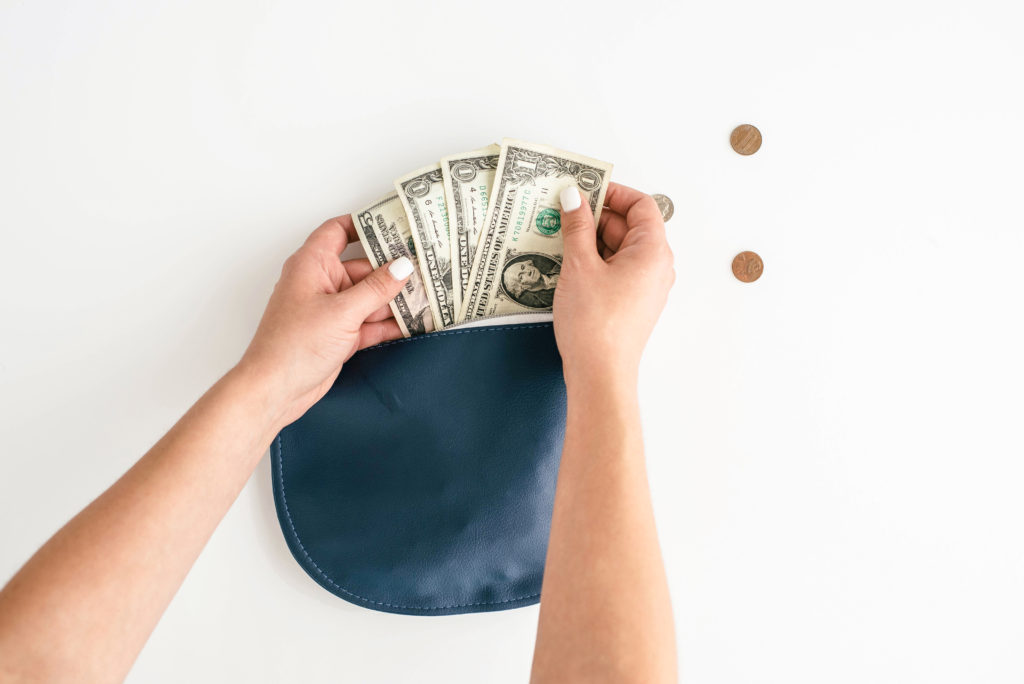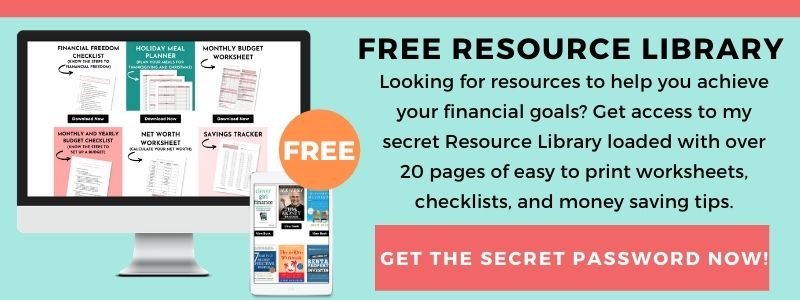Last Updated January 27, 2021
Trying to save more money every month? Cutting expenses is an easy way to free up some money so you can achieve your other financial goals much faster. Find out how you can save more money by cutting your monthly expenses.
Importance Of Cutting Your Monthly Expenses
Cutting your expenses is important because the less you spend, the less money you will need overall to achieve financial freedom. You need to cut your expenses in order to achieve financial freedom more quickly. If you are used to spending frivolously, understand that embracing a frugal lifestyle will take time and won’t happen overnight.
To change this habit, you have to first make a budget and track your spending. If you’re just starting out, you can download my FREE Monthly Budget Worksheet.
However, if you want something a little more sophisticated, you can get my Budget Template. This is the template I use to save over 50% of my income every month.
List Of Monthly Household Expenses
Most people go wrong when making a budget because they accidentally leave out monthly expenses that will require money at some point. That can throw your whole budget off and make you feel like a failure.
So to avoid making that same mistake, here’s a list of some common household expenses you may want to include in your budget:
Housing:
- Rent or Mortgage
- Property Taxes
- Home Insurance
- Common Charges or HOA fees
- Maintenance
Transportation:
- Car Note
- Fuel
- Car Insurance
- Car Maintenance and Repairs
- Parking
- Taxis
- Public Transportation Costs
Utilities:
- Cell Phone
- Internet
- Cable
- Electricity
- Gas
- Water
Food:
- Dining Out
- Groceries
Entertainment:
- Going out with friends
- Bars
- Concerts
- Movies
- Vacations
Personal:
- Hair Cuts
- Hair Styling
- Nail and Skincare
- Dry Cleaning
- Clothes
- Student Loans
Health:
- Health Insurance
- Doctor Co-pays
- Medicine
- Health Club Dues
- Life Insurance
- Veterinarian and Pet Care
Gifts/Charity:
- Gifts Given
- Charitable Donations
- Religious Tithing.
Savings:
- Savings Account
- Emergency Fund
- Retirement Accounts
- Investments
If you want to get some more ideas of household expenses to include in your budget, you can download my FREE Budget Categories List. It’s a list of over 80 different household expenses.
This list is designed to cover as many personal budget expenses as possible; but don’t feel overwhelmed by its size, because not all will apply to you. This free list will make sure you don’t forget to include an expense in your budget.
Track Your Monthly Spending
After you make your budget, you need to make sure to track your spending regularly. Track your spending by keeping receipts and writing down all of your purchases. You cannot rely on your memory to keep track of your spending.

Use this FREE Daily Expense Tracker to help you with that. Print out multiple sheets (one for each spending category or sub-category). Then put all your sheets in one place (like a binder or folder).
If you don’t like to manually track your spending (like me), you can use a third-party website like Personal Capital to see your spending all in one place. Personal Capital is a FREE wealth management tool to help you get a better understanding of your finances.
After you link all your accounts, you can see all your accounts in one place to have better money oversight.
If you sign up today and link at least one of your investment accounts (with a balance of more than $1,000), we’ll each get $50. That’s FREE money for keeping track and staying on top of your finances (something you should be doing anyway)!
Once you make a budget and track your spending, it will become clearer to you where you can cut spending. Over time, being conscious about your spending is going to become second nature to you.
How To Drastically Cut Expenses?

So you made your budget and tracked your spending for the month, now it’s time to start cutting your monthly expenses. A lot of financial experts would recommend you review your budget and eliminate any small unnecessary expenditure—like your daily latte. However, if you want to drastically cut expenses, I think you need to first focus on cutting larger expenditures.
The reasoning is since most of your money goes towards the larger budget categories—such as housing, transportation, and food—those are the areas where you can make the biggest impact and recapture the most dollars.
For example, if I have allocated 35% of my budget to rent or mortgage, 15% to transportation, and 10% for food, that is 60% of my budget right there on only three spending categories.
One easy way to cut spending is to use a service such as Trim. Trim is a virtual personal assistant that constantly works to save you money. They analyze your spending patterns to find ways to save you money, set spending alerts, and automatically fight fees. Trim also negotiates cable, internet, phone, medical bills, cancels old subscriptions, and more.
Action Steps For Cutting Your Monthly Expenses

What are the three budget categories you spend the most in? At this point, it should be easy for you to answer this question because you can refer to your budget.
My Monthly Budget Template makes it clear how much of your income goes to what expense. It shows you exactly what percent of your income is being spent on each budget category. This makes it very simple for you to decide where you need to cut back at a glance.
By focusing on the larger parts of your spending, you are able to make the most impact when deciding to cut back. Keep in mind, I’m not saying you should not focus on the smaller categories at all, I’m just saying I would focus on cutting my expenses in my high spending categories before I turn to cutting my small expenditures.
Cutting Monthly Expenses To Pay Off Debt
If you have a lot of high-interest debt, cutting your monthly expenses are absolutely necessary! You have to attack that debt and pay it off as fast as possible in order to be financially free.
You can use this FREE Debt Tracker to help you track your debt payoff progress.
If you’re interested in using technology to help with your debt repayment plan check out Tally. Tally is an automated debt manager that makes it easy to save money, manage your cards and pay down balances faster.

The way it works is Tally analyzes your credit cards and finds ways to help you eliminate debt and save money. If you qualify, Tally gives you a line of credit with a low APR, then uses the new credit line to pay your credit cards every month. The low APR helps save you money on interest.
Tally manages all your credit cards in one simple app. They keep track of the balances, interest rates, and due dates for each card. That’s how Tally makes the right payment to the right card at the right time. All you have to do is make one monthly payment to Tally.
Tally is free to download, and they don’t charge any fees to use the app. The way they make money by charging interest on the amount borrowed (which is a lower interest rate than what your credit cards are currently charging you).
I highly recommend Tally because they only make money if they can save you money.
Another option is Undebt.it. It is a FREE tool to help you get out of debt. There are SEVEN debt payoff plans you can choose from (including the debt avalanche and debt snowball method). You can even compare the different payoff plans to see which is best for you or make your own custom plan!
They also have debt payoff calculators, which is also FREE. You can keep track of all your payments and your debt payoff progress in one place. This software is so AWESOME and absolutely FREE! I haven’t come across something this good in a while!
You can also sign up for the premium account that has more features for you to take advantage of. The premium account is $12 for the entire year (only $1/month), which is still very affordable.
There’s a 30-day FREE trial if you want to check out the premium account. What I would do is sign up for the free account first, and then click on the free trial to check out the premium features. If you like it, then sign up for the premium account.
Summary
Cutting your monthly expenses is an important part of becoming financially free. Start by making a budget and track your spending. Tracking your spending will make it clear to you where you can start cutting back on expenses. Focus on cutting large expenses first instead of getting rid of your weekly latte. Once you cut your expenses on your high spend areas, you can then focus on cutting the little things.
Related Articles:
- How I Saved $300,000 In 4 Years
- 3 Easy Ways To Cut Household Expenses
- Reduce Housing Expenses: How To Get Out Of Your Current Living Situation
If you want to remember this article, post it to your favorite Pinterest board.

















13 Comments on Cutting Your Monthly Expenses: Why It Is Absolutely Necessary